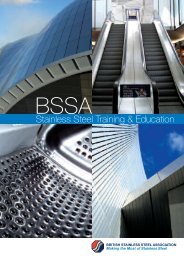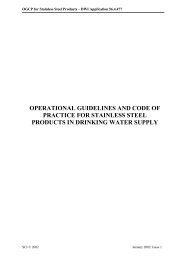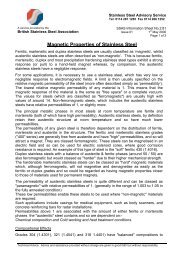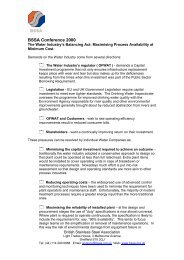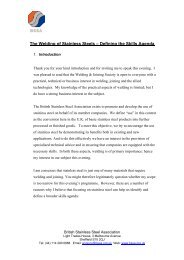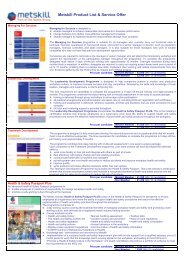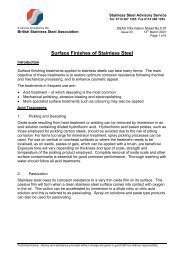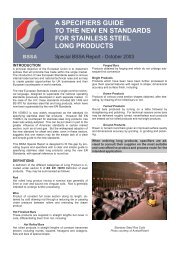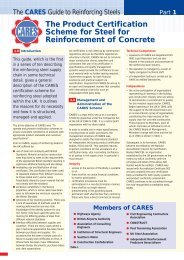Dry ice blasting of stainless steel - British Stainless Steel Association
Dry ice blasting of stainless steel - British Stainless Steel Association
Dry ice blasting of stainless steel - British Stainless Steel Association
Create successful ePaper yourself
Turn your PDF publications into a flip-book with our unique Google optimized e-Paper software.
ARCHITECTURE<br />
Picture 3. Flash rust already visible after<br />
a month, particularly by the welds.<br />
Picture 2. Wind barrier made from<br />
<strong>stainless</strong> <strong>steel</strong> 316L.<br />
methods are very labour-intensive<br />
and need to be repeated on a regular<br />
basis. In addition, certain<br />
requirements would need to be stipulated<br />
regarding the type <strong>of</strong> scouring<br />
product to be used, to avoid the<br />
possible problems as described<br />
above. It is therefore important to<br />
consider innovations in contaminant<br />
removal. One such method,<br />
which is particularly noteworthy, is<br />
the use <strong>of</strong> dry <strong>ice</strong> <strong>blasting</strong>.<br />
very user-friendly. Furthermore, as<br />
the carbon dioxide is created during<br />
the production <strong>of</strong> industrial gases,<br />
the CO2 is returned to the atmosphere,<br />
making dry <strong>ice</strong> <strong>blasting</strong> a<br />
very environmentally-friendly<br />
process. The following lists the<br />
main features <strong>of</strong> this method:<br />
additional investment, it would<br />
therefore be better to leave this task<br />
to specialist companies.<br />
There are three main stages to<br />
cleaning with dry <strong>ice</strong>:<br />
1. Mechanical: the dry <strong>ice</strong> pellets<br />
accelerate in the air stream and<br />
DRY ICE BLASTING<br />
<strong>Dry</strong> <strong>ice</strong> <strong>blasting</strong>, also known as<br />
cryogenic <strong>blasting</strong>, is a cleaning<br />
process whereby compressed frozen<br />
carbon dioxide (CO2), or dry <strong>ice</strong>, is<br />
allowed to sublimate under high<br />
pressure on a contaminated or<br />
lightly rusted surface. A high-pressure<br />
jet is used to blast the <strong>ice</strong>, at a<br />
temperature <strong>of</strong> -79° C, onto a contaminated<br />
<strong>stainless</strong> <strong>steel</strong> surface,<br />
which is warm by comparison. This<br />
then causes a ‘thermo shock’,<br />
which considerably loosens any<br />
contamination and flash rust, and<br />
the dry <strong>ice</strong> evaporates instantly. The<br />
dry <strong>ice</strong> rapidly converts into carbon<br />
dioxide gas and expands about 700<br />
times in volume. This produces a<br />
sort <strong>of</strong> explosion on the surface,<br />
which thoroughly removes all contaminants.<br />
As carbon dioxide has<br />
no liquid state, there is no moisture<br />
to be found, which explains the<br />
term ‘dry <strong>ice</strong>’. A significant advantage<br />
is that no damp residue is left<br />
behind which makes this method<br />
Picture 4. Rust pits showing on the design’s posts.<br />
• A quick, dry process;<br />
• No addition <strong>of</strong> chemicals;<br />
• Non-toxic, therefore kind to users<br />
as well as the environment;<br />
• No waste;<br />
• No disassembly <strong>of</strong> equipment<br />
required before cleaning,<br />
enabling higher productivity;<br />
• No scouring effect, so no surface<br />
damage;<br />
• Cost savings.<br />
The only drawback is that special<br />
equipment is required. To avoid<br />
hit the contaminants at high<br />
velocity, removing the majority<br />
<strong>of</strong> them;<br />
2. Thermal: the low temperature <strong>of</strong><br />
the dry <strong>ice</strong> makes the material to<br />
be removed more brittle, aiding<br />
its further removal (thermo<br />
shock);<br />
3. Sublimation: the rapid conversion<br />
<strong>of</strong> the solid dry <strong>ice</strong> into gas<br />
produces an explosion on the<br />
surface, eliminating the remaining<br />
contaminants and rust.<br />
▲<br />
32 S T A I N L E S S S T E E L W O R L D A P R I L 2 0 0 6 www.<strong>stainless</strong>-<strong>steel</strong>-world.net



